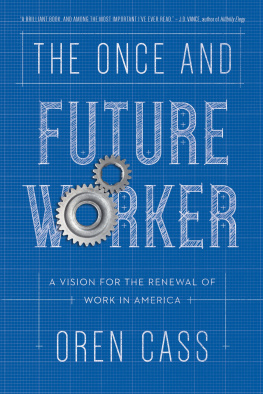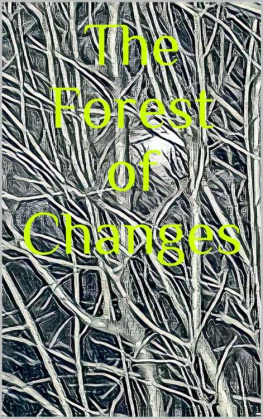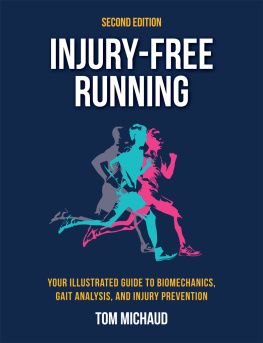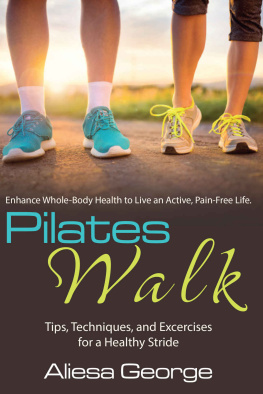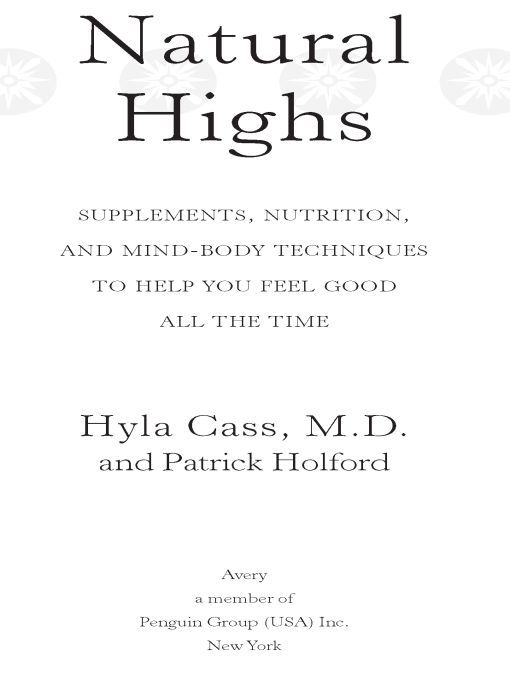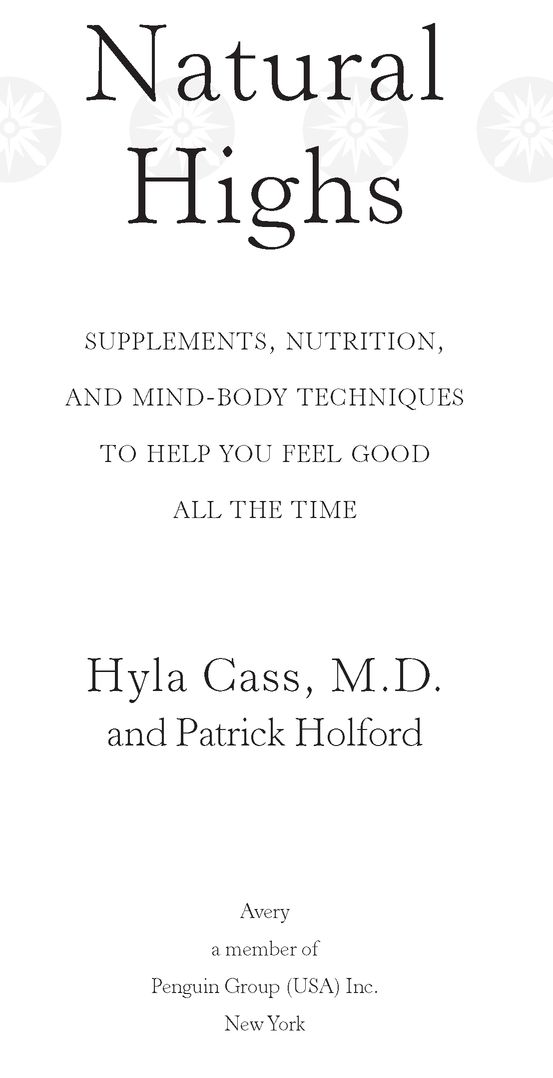Table of Contents
Other books by Dr. Hyla Cass
Kava: Natures Answer to Stress, Anxiety,
and Insomnia (with Terrence McNally)
St. Johns Wort: Natures Blues Buster
Users Guide to Ginkgo Biloba (with Jim English)
Users Guide to Vitamin C (with Jim English)
Other books by Patrick Holford
The Optimum Nutrition Bible
100% Health
The Optimum Nutrition Cookbook (with Judy Ridgway)
6 Weeks to Superhealth
Balance Hormones Naturally (with Kate Neil)
Beat Stress and Fatigue
Boost Your Immune System (with Jennifer Meek)
Improve Your Digestion
Say No to Cancer
Say No to Heart Disease
Say No to Arthritis
The 30 Day Fat Burner Diet
Supplements for Superhealth
The Little Book of Optimum Nutrition
Solve Your Skin Problems (with Natalie Savona)
Acknowledgments
This book would not have been possible without the help and support of many people. We would both like to thank Ken Blum, Ph.D., Jerry Cott, Ph.D., Charles Grob, M.D., Abram Hoffer, M.D., Ann Shulgin, Alexander (Sasha) Shulgin, Ph.D., and Rick Strassman, M.D., for their guidance and research input.
I would like to thank Jeremy Tarcher, who first sparked to the idea; Joel Fotinos at Tarcher, who adopted it; John Duff at Avery and the editorial team, who saw it through to completion. Special thanks to Executive Editor Laura Shepherd, who shared my vision, was endlessly supportive, and did an incredible job of editing. Thanks, too, to copyeditor Carol Rosenberg. Thanks to my family, including my mother, Miriam; my three sisters and their husbands; and my daughter, Alison, and my son-in-law, Seth. Thanks also to my many friends who advised and supported me.
Special thanks to Terrence McNally, who helped me to write and rewrite, was always available for feedback, and reminded me to take a break now and then; and to Jim English, who, besides doing a great job on the diagrams, had the gift of understanding my meaning and helped me to communicate it more artfully. Above all, I thank my patients, who have trusted me with their well-being and have taught me what I know.
Hyla Cass
I would like to thank Oscar Ichazo and many other people who have helped with guidance and research; and Bebe Kohlap for taking care of things during my absences. Very special thanks go to Natalie Savona for help with editing and to Rachel Winning and her team at Piatkus, especially Barbara Kiser, for their painstaking editing and design.
Patrick Holford
Introduction
Imagine living in a world where you feel happy, alert, and energetic more often than nota place where feeling high and at one with the world is the norm, where getting high is healthy and nonaddictive. Does this sound like science fiction? As well see, it can be as simple as childs play, where it all begins.
Pass any playground full of five- or six-year-olds, and you are immediately struck by the bubbling energy that radiates from this running, laughing, shouting sea of children. They embrace the world and interact with it in a way that many of us have forgotten. We seldom find a young child who is the least bit shy about singing, dancing, or drawing in front of others. But how many of us would even contemplate doing the same?
Spontaneous and positive, children are naturally high. They will go out of their way to enhance this, too, by swinging on swings or spinning in circles until they collapse. Even their crying and angry outbursts are an essential part of this spontaneity. As we approach adolescence, however, we become socialized and lose some of this seemingly innate capacity for fun and pleasure.
As adults, we adopt repetitive and rote behaviors; we surrender and become numb to life. We forget to smell the flowers (sensory awareness), appreciate our loved ones (an open heart), and take pleasure in finding new ways of doing things (mental flexibility). But are these losses inevitable? Is it possible for us to experience the open, spontaneous, and energetic joy we once had? In Natural Highs, we discuss how we can once again embrace this more childlike state. One vital key to sustaining mood, energy, and connection is to be aware, present, and open to new ideas, behaviors, and perceptions.
In the following chapters, youll discover everything you need to experience a natural, childlike high. We include a range of techniques and nutrients designed to promote sensory awareness and mental flexibility, as well as to restore and maintain your energy level. Youll then be able to find your own perfect combination of diet, nutrients, and activities for staying naturally high, including:
Hangover-free alternatives to relaxing with a beer, martini, or a glass of wine.
Natural, nonaddictive ways to get the same energy kick that you get from coffee, tea, or tobacco.
Safe, natural, and effective alternatives to Prozac and Valium, with no side effects.
Natural nutrients to help take you to higher states of awareness and connection, without the side effects of drugs.
Nourishing foods that can replenish and restore your brain, depleted by stress or excessive drug and alcohol use.
Natural substances that help you escape addictions, including some that you may not even realize you have.
Youll quickly see that getting high can be healthy, nonaddictive, and as easy as taking a quick trip to the supermarket, drugstore, or health food store.
Altering Mind, Mood, and Energy
At this point you may be questioning whether it is even natural to feel this good all the time! It certainly isnt the norm in our culture. And, in fact, evidence suggests that depression and anxiety may offer evolutionary advantages. Our ancestors knew that maintaining an edge and keeping a vigilant eye out for enemies had great survival value. Being too blissed-out might make you some predators dinner! Despite the absence of this ongoing threat, many of us are still on edge, anxious, and/or depressed. If this sounds like you, the good news is that there are natural, mind-altering supplements and techniques that can help you to break your patterns and create new and happier responses to lifes inevitable changes, disappointments, and surprises.
Of course, natural can mean a lot of things these days. Coffee, alcohol, nicotine, marijuana, and even cocaine all are provided by Mother Nature, but theyre not on our recommended list. By natural, we mean substances that are both legal and good for you. Such substances work with your bodys design, not against it. Used correctly, they can balance and increase health and energy rather than deplete it.
Feel-good substances permeate our culture. In an average week, Americans drink 3.4 million cups of tea, 1 billion cups of coffee, 4.5 billion sugared and/or caffeinated soft drinks, 2.3 billion alcoholic drinks; smoke 8.25 billion cigarettes; and consume 845,726,369 pounds (or about 420,000 tons) of sugar and 20 million pounds of chocolate. On top of this we take 20 million antidepressants, puff our way through 25 million joints, and pop 1 million tabs of Ecstasy.
All that popping, pouring, and puffing wouldnt be so popular unless it worked. In fact, these substances can boost our energy, relieve our anxiety, help us recover from a hard days work, and escape our less than perfect reality. Unfortunately, these highs evaporate all too quickly, leaving us to cope with a nasty aftermath of mood swings, emotional depletion, physical exhaustion, and even addiction. If youve quit, thats probably why. And if you havent, its probably why youre reading this book.



